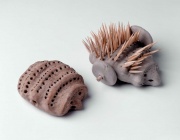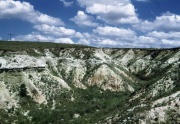Marl
Description
A friable mixture of clay that contains a high proportion of carbonate calcium carbonate. Marls are secondary clays that often contain sand, oxide iron oxide, and other impurities. Marls are most often used as alkaline additives to soil. As a pottery clay, marl tends to be clay aplastic and is often used for glaze slipware, earthenware, and brick. Some examples of marls used in pottery are (Fournier 1996):
- Keuper marl: contains carbonate magnesium carbonate and gypsum; variable in color
- Etruria marl: contains almost no lime
- Cambridge marl: contains about 40% lime
Synonyms and Related Terms
Keuper marl; Etruria marl; Cambridge marl; calcareous clay; marga (Port.)
Additional Information
R. Fournier, Illustrated Dictionary of Practical Pottery, Chilton Book Co., Radnor, PA, 1996.
Authority
- G.S.Brady, G.S.Brady, Materials Handbook, McGraw-Hill Book Co., New York, 1971 Comment: p. 118
- Henry Hodges, Henry Hodges, Artifacts: An Introduction to Early Materials and Technology, Ronald P. Frye, Kingston, Canada, 1988
- Robert Fournier, Robert Fournier, Illustrated Dictionary of Practical Pottery, Chilton Book Company, Radnor, PA, 1992
- Random House, Random House, Webster's Encyclopedic Unabridged Dictionary of the English Language, Grammercy Book, New York, 1997
- The American Heritage Dictionary or Encarta, via Microsoft Bookshelf 98, Microsoft Corp., 1998
- Art and Architecture Thesaurus Online, http://www.getty.edu/research/tools/vocabulary/aat/, J. Paul Getty Trust, Los Angeles, 2000

